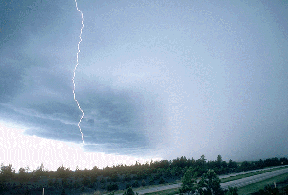
Now, let's discuss quickly the earth's surface in relation to moisture. Please study Behavioral Objective #18. Temperature variations over the surface of the earth and the earth's rotation are responsible for establishing major patterns of air circulation and of rainfall. These patterns depend to a large extent on the fact that cold air is denser than warm air, and consequently, warm air rises and cold air falls. But as air rises it encounters lower pressure and consequently expands, and as a gas expands it cools. It is a physical principle that cooler air can hold less moisture than warmer air. So when the warm air rises and cools it tends to lose its moisture and to form rain or snow.

Study the figure to the right as you read the next section.
Now we can consider how some climates are determined in terms of how much moisture they receive. We note that the equator is the hottest spot or the hottest area of the earth's surface because it receives the solar energy almost perpendicular to the surface of the earth and that during the major part of the year. Hence, the warmest air one will find may be at the zone of the equator. Hence, this warm air which is capable of holding a great deal of moisture will rise, but as it rises it cools and as it cools it loses its moisture. And after losing its moisture it descends. At the equator you will see that the warm air is rising and moving north in a northerly direction. It loses its moisture at about 15 degrees North and then descends as dry air at 30 degrees North. Now this cold, dry air is warmed by the sun's energy and picks up whatever moisture is around and rises again. This second rising of dry air that has picked up moisture actually causes the formation of desert regions. This warm air then rises and drops its moisture at about 45 degrees North and comes down again as cold, dry air at 60 degrees North. At this point we are up to the icy northern regions where the air is not warmed very readily by the sun or by the surface of the earth. However, it is warmed enough to cause it to rise but not warm enough to carry much moisture, so as this warm air rises it deposits what little moisture it has and comes down in the polar region as cold, dry air. Hence, in the polar region one would never expect to find rainfall.
Examine the picture showing the Earth's latitude positions and answer the following questions.

|
1. Where does warm dry air fall? 2. Where does hot moist air rise? 3. Where does cold dry air fall? 4. Where are the trade winds? 5. Where are the westerlies? |
A. 30 degree latitude B. Equator C. polar cap D. between 30 degree and 60 degree lat. E. between 0 degree and 30 degree lat. |
|||
|
Choose the correct order of answers.
|
||||
Created by the Multimedia Development Lab, Academic Technology Services.
Last modified November 19, 1997.